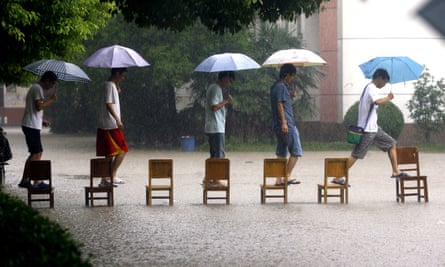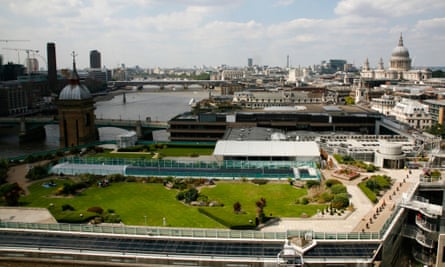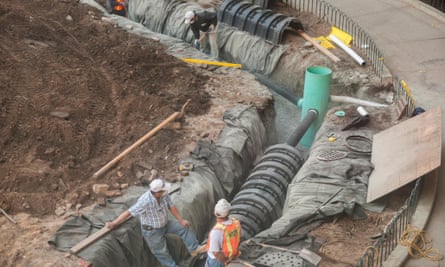Trillions of litres of free, fresh water drop from the sky onto the world’s cities each year – yet most of it is channelled straight into gutters, drains and rivers. At best, this represents a waste of a valuable natural resource. At worst, it can lead to devastating urban floods like the one in the Japanese city of Joso this month that killed eight and destroyed hundreds of homes.
With cities getting bigger and climate change threatening to bring more extreme weather, some scientists and politicians are proposing “sponge cities”, a reimagination of the urban environment where almost every raindrop is captured, controlled and reused.
Instead of funnelling rainwater away, a sponge city retains it for use within its own boundaries. Some might be used to recharge depleted aquifers or irrigate gardens and urban farms. Some could replace the drinking water we use to flush our toilets and clean our homes. It could even be processed to make it clean enough to drink.
“It’s a new way of thinking about stormwater, not as a problem but as an opportunity and a resource to augment our water supply,” says Richard Luthy, professor of civil and environmental engineering at Stanford University.
Nowhere has embraced the idea of sponge cities as enthusiastically as China, perhaps because few countries are wrestling so painfully with the twin problems of rapid urbanisation and poor water management. About half of China’s 657 cities are considered water scarce or severely water scarce by UN measures, and another half fail to reach national standards for flood prevention. While more than 230 cities were affected by flooding in 2013, 90% of older urban areas do not even have basic flood plans, say officials.

China has now chosen 16 urban districts across the country, including Wuhan, Chongqing and Xiamen, to become pilot sponge cities. Over the next three years, each will receive up to 600m yuan (£62m) to develop ponds, filtration pools and wetlands, as well as to build permeable roads and public spaces that enable stormwater to soak into the ground. Ultimately, the plan is to manage 60% of rainwater falling in the cities.
“A sponge city follows the philosophy of innovation: that a city can solve water problems instead of creating them. In the long run, sponge cities will reduce carbon emissions and help fight climate change,” says Qiu Baoxing, a former vice-minister of housing and urban-rural development.
How sponge cities work
Domestic rainwater harvesting is nothing new. Many homeowners have a rain barrel to collect the water falling on their roofs and use it for watering plants or cleaning. Scaling this up to large apartment towers and office blocks would be best accomplished with rooftop gardens, says Alicia An, a professor of energy and environment at the City University of Hong Kong.

An calculated that a cluster of buildings at her university installed with rooftop gardens could catch enough rain to replace up half of all the toilet water they use. The balmy gardens would also reduce the tropical air temperature by around 1.3C nearby, reducing the energy needed to cool the building.
At ground level, impervious concrete can be replaced by bioswales, ditches filled with native plants that naturally collect and filter rainwater. That water can then either be allowed to seep into the soil to replenish the groundwater or be collected in underground cisterns.

In Los Angeles, Luthy is helping to develop a disused 50-acre rock quarry into a park-like facility that will capture stormwater, treat it to remove pollutants and then recharge the city’s groundwater. The system should eventually be able to store more than a billion litres of water. “The idea is that you’d put water into it year after year and then pump it out when you get into a drought,” he says. “The ground becomes your savings bank for water.”
In less-developed areas, controlling stormwater can mean more than just a stable water supply and a nice park. The World Resources Institute estimates that 21 million people worldwide are affected by river floods each year, a number that could rise to 54 million in 2030 due to climate change and socio-economic development.
While digging bioswales can be a quick fix, transforming entire cities into sponges will require massive investment. Few buildings or municipalities have a “grey water” infrastructure to transport fresh but untreated water like rainfall, and replacing kilometres of concrete or building massive underground cisterns (plus the smart systems to control them) is a pricey proposition. In a neighbourhood of east LA, for example, a single block known as Elmer Avenue with 24 homes has spent around $2.7m (£1.78m) on a retrofit programme to harvest water, reducing flooding and enabling the city to bank water for future use.
But the changes can make financial sense in the long term. When Changde, a city 1,200km west of Shanghai, replaced 15% of its hard-standing with bioswales, it cut its engineering bill for new drains in half.
Sponge cities also come with wider social benefits, according to Luthy. “At nearly $50m, the LA quarry project is expensive but it gets support from lots of groups,” he says. “The city likes it because it can provide water. Surfers like it because when you capture stormwater, you’re preventing beach pollution. Environmental groups like it because you’re greening the city and local residents like it because you’re taking an urban blight and converting it to a community resource.”
- You can read our full ‘water in cities’ series here

Comments (…)
Sign in or create your Guardian account to join the discussion